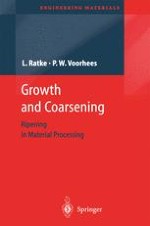2002 | OriginalPaper | Chapter
Coarsening — Basics and Growth Laws
Authors : Professor Dr. Lorenz Ratke, Professor Peter W. Voorhees
Published in: Growth and Coarsening
Publisher: Springer Berlin Heidelberg
Included in: Professional Book Archive
Activate our intelligent search to find suitable subject content or patents.
Select sections of text to find matching patents with Artificial Intelligence. powered by
Select sections of text to find additional relevant content using AI-assisted search. powered by
Imagine a system consisting of a huge number of particles of a certain phase with different radii embedded in a matrix. Some examples are shown in the introduction in figs.1.3 and 1.6. Assume further that the alloy is held at a constant annealing temperature. The concentration of solute in the matrix shall be at a level given approximately by the phase diagram and the annealing temperature. What will happen to the dispersion of particles? Generally one will observe in experiments that the particle radii change with annealing time, the average radius will grow, the number of particles decreases, but the overall volume fraction remains nearly a constant. An example of such a behavior is shown in Fig. 6.1. Why do these changes in particle size occur? Generally speaking, a dispersion of solid or liquid particle in a matrix increases the overall energy due to the existence of interfacial energy associated with the interfacial area. Since the system tries to minimize the energy, the amount of interfacial area decreases with time. A large number of small particles has, however, more interfacial area than one large particle with the same volume. Thus, the energy contained in the interfacial area of a dispersion increases with the number of particles in the dispersion. Reducing the number of particles decreases the excess energy associated with the interfaces. Therefore, a dispersion coarsens or ripens.
